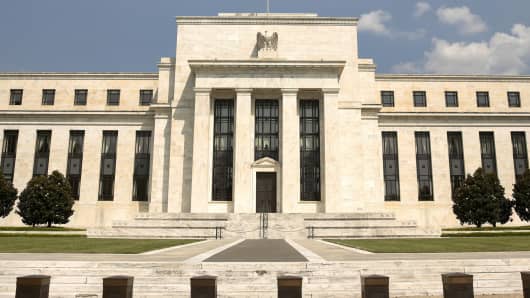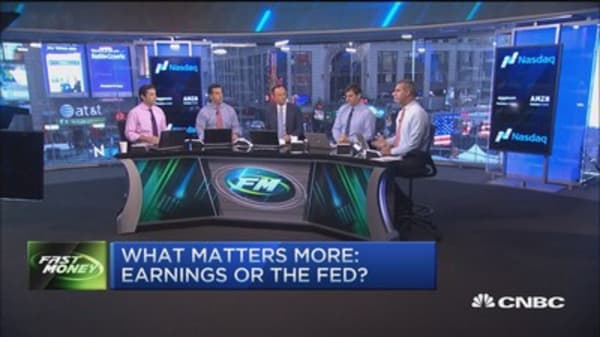Increasing monetary creation
There is nothing that I can see to suggest that the Fed is poised for an interest rate increase. In fact, there is evidence that a mild contraction of monetary creation earlier this year was reversed in June. Since then, the monetary base (the liability side of the Fed's balance sheet) has been expanding. Between the end of June and the middle of October, the Fed's monetary base increased by 3.5 percent.
Clearly, that is not a sign that the Fed is ready to initiate what is widely known as an interest rate normalization process, or, put more simply, the departure from the current 0-0.25 percent interest rate target. This key policy rate is systematically kept around the middle of that range.
Now, I continue to stay away from the timing game - a game where, after an egregious September miss, timers' forecasts now go from the end of this year, to the first quarter of next year, or even the beginning of 2017.
In any event, whoever wants to play that game may wish to note that what the Fed is doing now shows a strong commitment to an exceptionally easy policy stance. There are important domestic and international reasons for such a decision.
A substantial slack still remains in U.S. labor markets despite improving headline indicators. The actual number of unemployed, or underemployed, people is still 15.8 million. That is exactly double the reported unemployment if one adds the involuntary part-time workers (people working part-time because they cannot get a full-time job), and people who are no longer looking for a job mainly because they could not find work.
There are no imminent inflation threats. The CPI in September was flat. True, that was mostly a result of an 18.4 percent annual decline of energy costs, but a rate hike would still be difficult to justify at a time when the general level of inflation is zero, and when the outlook for energy prices indicates a continuing weakness.
Read MoreIs the US headed for negative interest rates?
Other inflation indicators also remain subdued. Reflecting the prevailing excess supply of labor, unit labor costs in the first half of this year rose 1.4 percent from the year earlier, showing a substantial slowdown from 2.2 percent in the first half of last year and from 2.1 percent for 2014 as a whole. The same trend is observed with regard to the nominal hourly compensation.
Banks' slowing consumer lending
More broadly, activity indicators are suggesting a continuation of moderate economic growth with no capacity pressures. The latest surveys show some weakening in service and manufacturing sectors, with sharp drops in new orders and order backlogs. The industrial production in September increased a puny 0.4 percent year-over-year (after monthly declines in July and August), and the capacity utilization rate of 77.5 percent is far below the long-term average of 80.1 percent.
And here is also an interesting detail closely watched by the Fed. In spite of sharply rising excess reserves (i.e. loanable funds) in the banking sector (+4.7 percent since last June), bank lending to consumers has slowed down since the beginning of the year to an annual growth rate of 5 percent.
Was that due to the households' softening loan demand? It does not look that way because the non-bank lending to consumers continues to grow at an annual rate of more than 8 percent.
Why are the banks shying away from their core business of lending to consumers? Is the Fed having a problem with the banking sector again?
Raising credit costs under these circumstances would send a disquieting signal to financial markets and the rest of the economy. An interest rate increase that would induce capital inflows and a rising dollar would also weaken America's import-competing industries. The dollar's 12 percent trade-weighted increase in the year to mid-October has already taken its toll on the U.S. foreign trade. In the first eight months of this year, the trade deficit came in at $500.1 billion, a 3 percent increase from the year before.
And this could get much worse, costing America an estimated 1 percentage point of its growth in domestic demand for this year as a whole. A big drag indeed on America's economic growth.
But there is nothing the U.S. can do about the economic, political and social chaos in Europe, a destination for one-fifth of American export sales. Helped by the weaker euro, and limited in their ability to generate internal growth, most European countries – led by Germany – are pushing exports to an open and growing U.S. market to stay afloat. In the first eight months of this year, the U.S. trade deficit with Europe rose 8 percent.
America's trade with Asia is much worse. So far this year, the U.S. trade deficit with the countries of that area soared 15 percent. And, please recall, these are the countries that keep complaining – along with the IMF – about the Fed's widely publicized intentions to begin raising interest rates. Why should they complain? They should relax and enjoy the ride, as their weakening currencies boost their exports to a welcoming U.S. market.
Read MoreFed could be a snooze, but these reports will be big
Investment thoughts
The Fed is responding to (a) the lingering slack in U.S. labor markets, (b) absence of inflation pressures and (c) self-inflicted wounds of mismanaged European and Asian economies. As things now stand, the Fed is not even contemplating an interest rate hike in the months ahead.
With subdued labor costs in a growing economy increasing amounts of value-added will go into profit shares. U.S. equities are still one of the best, and safest, bets around.





